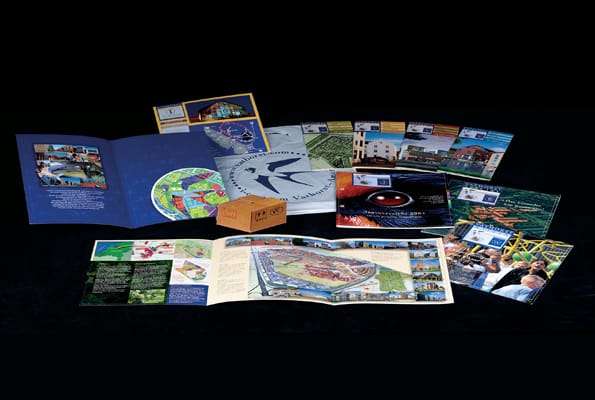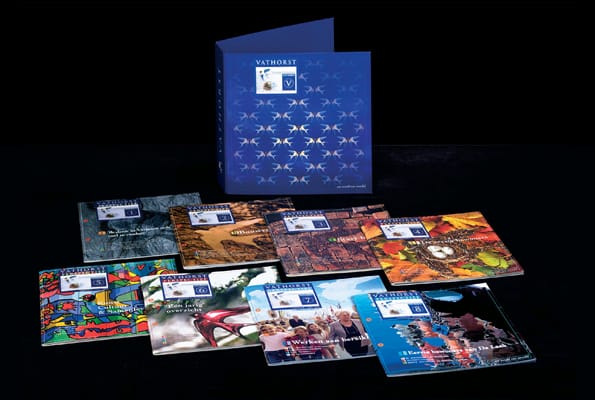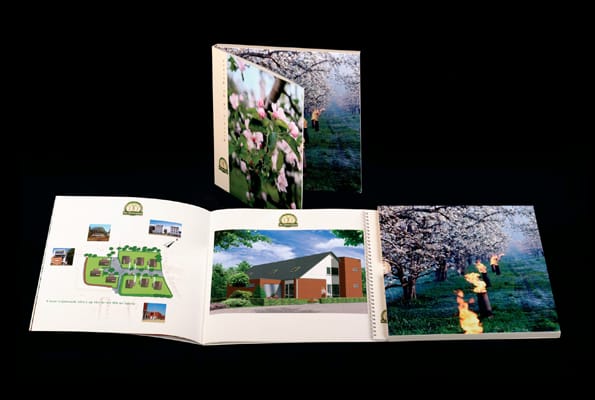Graphic design uses visual compositions to solve problems and communicate ideas through typography, imagery, color and form. There’s no one way to do that, and that’s why there are several types of graphic design, each with their own area of specialization.
1. Visual identity graphic design
A brand is a relationship between a business or organization and its audience. A brand identity is how the organization communicates its personality, tone and essence, as well as memories, emotions and experiences. Visual identity graphic design is exactly that: the visual elements of brand identity that act as the face of a brand to communicate those intangible qualities through images, shapes and color.
As a visual identity graphic design specialist, I collaborate with brand stakeholders to create assets like logos, typography, color palettes and image libraries that represent a brand’s personality. In addition to the standard business cards and corporate stationary, I often develop a set of visual brand guidelines (style guides) that describe best practices and provide examples of visual branding applied across various media. These guidelines help to ensure brand consistency throughout future applications.
2. Marketing & advertising graphic design
Companies depend on successful marketing efforts to tap into their target audience’s decision-making process. Great marketing engages people based on the wants, needs, awareness and satisfaction they have about a product, service or brand. Since people will always find visual content more engaging, graphic design helps organizations promote and communicate more effectively.
Examples of marketing graphic design:
Postcards and flyers
Magazine and newspaper ads
Posters, banners and billboards
Infographics
Brochures (print and digital)
Vehicle wraps
Signage and trade show displays
Email marketing templates
PowerPoint presentations
Menus
Social media ads, banners and graphics
Banner and retargeting ads
Images for websites and blogs
3. User interface graphic design
A user interface (UI) is how a user interacts with a device or application. UI design is the process of designing interfaces to make them easy to use and provide a user-friendly experience.
A UI includes all of the things a user interacts with—the screen, keyboard and mouse—but in the context of graphic design, UI design focuses on the user’s visual experience and the design of on-screen graphic elements like buttons, menus, micro-interactions, and more.
Examples of user interface graphic design:
Web page design
Theme design (WordPress, Shopify, etc.)
Game interfaces
App design
4. Publication graphic design
Publications are long-form pieces that communicate with an audience through public distribution. They have traditionally been a print medium. Publication design is a classic type of design—think books, newspapers, magazines and catalogs. However, there’s recently been a significant rise in digital publishing.
Examples of publication graphic design:
Books
Newspapers
Newsletters
Directories
Annual reports
Magazines
Catalogs
5. Packaging graphic design
Most products require some form of packaging to protect and prepare them for storage, distribution, and sale. But packaging design can also communicate directly to consumers, which makes it an extremely valuable marketing tool. Every box, bottle and bag, every can, container, or canister is a chance tell the story of a brand.
6. Motion graphic design
Simply put, motion graphics are graphics that are in motion. This can include animation, audio, typography, imagery, video and other effects that are used in online media, television and film. The medium’s popularity has skyrocketed in recent years as technology improved and video content became king.
Examples of motion graphic design:
Title sequences and end credits
Advertisements
Animated logos
Trailers
Presentations
Promotional videos
Tutorial videos
Websites
Apps
Video games
Banners
GIFs
7. Environmental graphic design
Environmental graphic design visually connects people to places to improve their overall experience by making spaces more memorable, interesting, informative or easier to navigate. Environmental design is a broad type of design, here are some examples:
Examples of environmental graphic design:
Signage
Wall murals
Museum exhibitions
Office branding
Public transportation navigation
Retail store interiors
Stadium branding
Event and conference spaces
Wayfinding is a specific type of environmental graphic design that consists of strategic signage, landmarks and visual cues that help people identify where they are and where they need to go so they can get there without confusion.
8. Art and illustration for graphic design
Graphic art and illustration are often seen as being the same as graphic design, however they’re each very different. Designers create compositions to communicate and solve problems, graphic artists and illustrators create original artwork. Their art takes a number of forms, from fine art to decoration to storytelling illustrations.
Even though graphic art and illustration are not technically types of graphic design, so much is created for commercial use within the context of graphic design that you can’t talk about one without the others.
Examples of art and illustration for graphic design:
T-shirt design
Graphic patterns for textiles
Motion graphics
Stock images
Graphic novels
Video games
Websites
Comic books
Album art
Book covers
Picture books
Infographics
Technical illustration
Concept art









